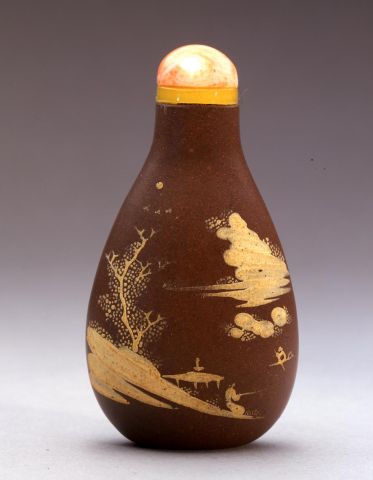
Bottle ID: 152
PEAR SHAPE WITH BUFF SLIP
Date: 1820-1860
Height: 59 mm
Stoneware, of pear shape tapering to a long slender neck and with an oval indented foot, the brown material decorated with a buff colored slip, with on one side a fisherman sitting on a rock beside his pavilion under pine, another fisherman on the lake bordered by a mountainous landscape, the reverse with sprigs of bamboo and a butterfly.
Attributed to Yixing.
Similar Examples:
Lawrence, Clare. Miniature Masterpieces from the Middle Kingdom - The Monimar Collection of Chinese Snuff bottles, 1996, pp. 216-217, no. 102.108.
Kleiner, Robert. Chinese Snuff Bottles in The Collection of Mary and George Bloch, 1995, pp. 367-368, no. 240.
Moss, Hugh, Victor Graham and Ka Bo Tsang. The Art of the Chinese Snuff bottle - The J & J Collection, 1993, Vol. I, p.421, no. 252.
Holden, Rachelle R. Rivers and Mountains Far From the World - The Rachelle R. Holden Collection, 1994, p. 264-265, no. 114.
The Art of the Yixing Potter. The K. S. Lo Collection, 1990, p. 97, no. 52.
Provenance:
Clare Lawrence Ltd.
Joseph Baruch Silver
Richerson Rhodes, no. 50
John G. Ford
Edward Choate O’Dell, no. 358
Exhibited:
Honolulu Academy of Arts, Honolulu, Hawaii, November 23, 1989 - January 7, 1990
Israel Museum, Jerusalem, Israel, 1987-1988
Published:
Chinese Snuff Bottles from the Collection of Joseph Baruch Silver in Conjunction with the exhibition at the Israel Museum, Jerusalem, Winter 1987, p. 35, no. 60
JICSBS, September 1978, front cover
Yixing was, and still is, known as the pottery capital of China. Although a small county in Jiangsu Province, it has been responsible for much of the production of what is known as “purple clay” wares since the Ming period. The mountains of Yixing contain alluvial clay which is particularly suitable for the potters in the production of predominately teapots. The center of production was Dingshuzhen, although in close proximity was Shoushan, known for its fine wares and Dingshan, known for its more coarse output. In 1976 shards of pottery tea vessels were excavated from the “Dragon Kiln” site near to Yangjiaoshan in Yixing. Since the Kiln could be dated to the Song Period, it is clear that production of wares must have pre-dated even the Ming Dynasty. The discovery of purple clay at Yixing is traditionally attributed to an eccentric monk who came into a local village one day shouting: “Riches and honors for sale”. When the villagers laughed at him, he shouted: “If you will not buy honors, why not buy riches?” The monk took the villagers to the site and showed them the clay which “was variegated and as beautiful as brocade” (quoted from Zhou Gaoqi Yangxian minghu xi in the late Ming period).
The use of a buff colored slip against a dark colored ground provides a dramatic and three dimensional image of a traditional scene in Chinese painting.

 English
English 中文
中文